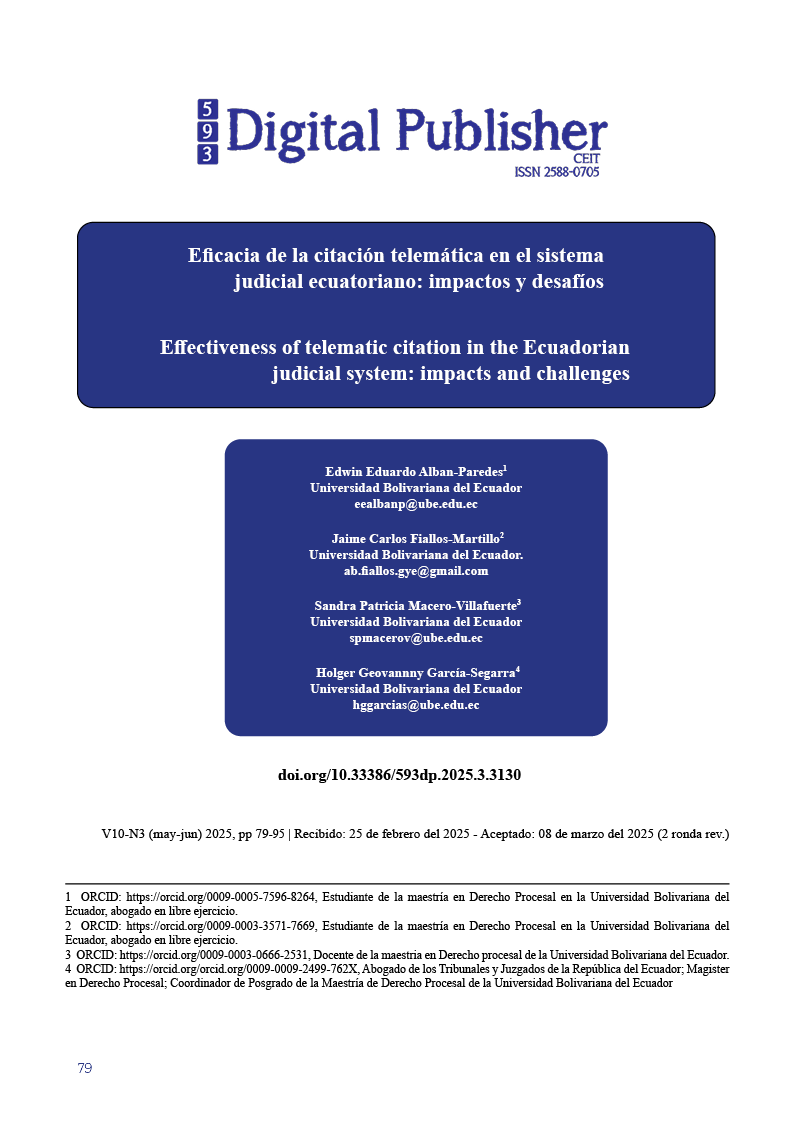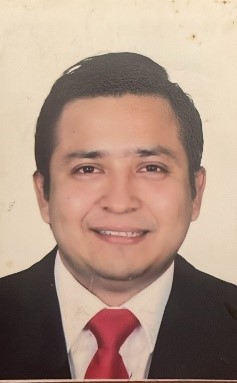Effectiveness of telematic citation in the Ecuadorian judicial system: impacts and challenges
Main Article Content
Abstract
The present research paper analyzes telematic summons in non-criminal judicial processes of the Ecuadorian judicial system, an innovative legal figure recently incorporated into the Ecuadorian procedural system. Its implementation aims to modernize and expedite the administration of justice. However, it presents significant challenges in its operability, such as the need to activate the citizen mailbox and the electronic notification system, which are not yet fully functional. Article 55 of the General Organic Code of Processes (2016) establishes that when the recipient of the summons cannot be located or their address cannot be determined, telematic summons will be used before resorting to summons by the press. This provision limits the efficiency of telematic summons by relegating it to an intermediate step, which contravenes its purpose and the principle of procedural speed. The objective of this research is to identify the operational difficulties of telematic citation through a qualitative approach, using document review as the main technique. The findings highlight the need to implement legal reforms that optimize telematic citation and promote procedural speed, which is crucial for strengthening the Ecuadorian judicial system.
Downloads
Article Details

This work is licensed under a Creative Commons Attribution-NonCommercial-ShareAlike 4.0 International License.
1. Derechos de autor
Las obras que se publican en 593 Digital Publisher CEIT están sujetas a los siguientes términos:
1.1. 593 Digital Publisher CEIT, conserva los derechos patrimoniales (copyright) de las obras publicadas, favorece y permite la reutilización de las mismas bajo la licencia Licencia Creative Commons 4.0 de Reconocimiento-NoComercial-CompartirIgual 4.0, por lo cual se pueden copiar, usar, difundir, transmitir y exponer públicamente, siempre que:
1.1.a. Se cite la autoría y fuente original de su publicación (revista, editorial, URL).
1.1.b. No se usen para fines comerciales u onerosos.
1.1.c. Se mencione la existencia y especificaciones de esta licencia de uso.
References
Asamblea Nacional. (2008). Constitución de la República del Ecuador. Quito: Registro Oficial 449 de 20-oct.-2008. Última modificación: 04-feb-2021
Asamblea Nacional. (2015). Código Orgánico General de Procesos COGEP. Quito: Registro Oficial Suplemento 506 de 22 de mayo del 2015. (Ecuador)
Wong, N. (2024). Citación telemática y derecho a la defensa de las personas adultas mayores en el ordenamiento jurídico ecuatoriano [Maestría en Derecho Procesal y Litigación Oral, Universidad Tecnológica Indoamérica]. https://repositorio.uti.edu.ec/bitstream/123456789/6839/1/WONG%20VIVAS%20NIXON%20ANDRES.pdf
Dirección Nacional de Registro de Datos Públicos. (2021). Norma que regula el procedimiento de integración al Sistema de Notificaciones Electrónicas (SINE). Quito: Registro Oficial 377 de 25 de enero del 2021.
Herrera, F. G. (2023). El Debido Proceso en Materias no Penales frente a la Citación por Medios Telemáticos. Ciencia Latina Revista Científica Multidisciplinar, 7(5), 6133-6161. https://doi.org/10.37811/cl_rcm.v7i5.8206
López-Paredes, P., & Gende-Ruperti, C. (2022). Vulneración al derecho del debido proceso: Perspectiva desde los Derechos Humanos en Ecuador. 593 Digital Publisher CEIT, 7(1-1), 724-734. https://doi.org/10.33386/593dp.2022.1-1.1027
Ministerio de Telecomunicaciones y Sociedad de la Información. (2024). Norma técnica que regula la administración y operación del Sistema Único de Notificación y Gestión de Trámites del Estado. Quito: Registro Oficial Suplemento 589 de 28 de junio del 2024.
Vanegas Morán, F. (2023). La implementación práctica de la citación electrónica de manera formal y el derecho a la defensa como garantía del debido proceso [Trabajo de Graduación, Universidad del Azuay]. https://dspace.uazuay.edu.ec/bitstream/datos/13706/1/19230.pdf
Proenza, J. (2019). Derecho informático y su aplicación en el Ecuador. Corporación de Estudios y Publicaciones (CEP), Quito.
Toro Peña, J. (2018). Actividad procesal. En García Falconí, R. y Pérez-Cruz Martín, A. (Dirs. Y Coords.), Código Orgánico General de Procesos Comentado. Latitud Cero Editores, Quito.
Wlasic, J. C., Puentes, M. E. F., & Lanza, D. A. (1998). Convención americana sobre derechos humanos: anotada y concordada con la jurisprudencia de la Corte Interamericana de Derechos Humanos.
Lascano, D. (2024). LA CITACIÓN ELECTRÓNICA EN RELACIÓN AL DERECHO A LA DEFENSA EN EL ECUADOR [Proyecto de Investigación previo a la obtención del título de Abogada, Pontificia Universidad Católica del Ecuador]. https://repositorio.puce.edu.ec/server/api/core/bitstreams/5335c4b3-d30c-40b2-85eb-a37499af9729/content
Yepez & Vaca Abogados. (2022). CITAR O COLAPSAR UN CAMBIO DE MODELO URGENTE. En Yepez & Vaca Abogados. https://yepezvaca.com/wp-content/uploads/2022/03/Citar-o-COLAPSAR.pdf
Camimura, L. (2022). La citación del acusado en un tribunal de reclamos menores es más efectiva cuando se realiza electrónicamente. https://www.cnj.jus.br/citacao-de-reu-em-juizado-especial-e-mais-efetiva-quando-feita-eletronicamente/
Santos, D. (2022). Citación electrónica y la modernización del entorno judicial. Demarest. https://www.demarest.com.br/citacao-eletronica-e-a-modernizacao-do-ambiente-judiciario/
Mamani, O. (2020). Universalización de la notificación electrónica como mecanismo esencial, seguro y eficaz para la realización y vigencia del debido proceso [Tesis para obtener el grado académico de Magíster en Derecho, Pontificia Universidad Católica de Perú]. https://tesis.pucp.edu.pe/items/e3e75188-a84e-4e33-9957-0257fc5d6a99
Rojas, T. (2014). La notificación virtual y su implementación en la administración de justicia en el Perú. Revista Jurídica Científica SIIAS, 7. https://revistas.uss.edu.pe/index.php/SSIAS/article/view/160
Código General del Proceso. [COGEP]. 2012.https://www.cancilleria.gov.co/sites/default/files/tramites_servicios/apostilla_legalizacion/ley_1564_de_2012_codigo_general_del_proceso.pdf
Congreso de Colombia. (2022) Ley 2213. https://www.funcionpublica.gov.co/eva/gestornormativo/norma.php?i=187626#:~:text=Esta%20Ley%20tiene%20por%20objeto,ante%20la%20jurisdicci%C3%B3n%20ordinaria%20en





